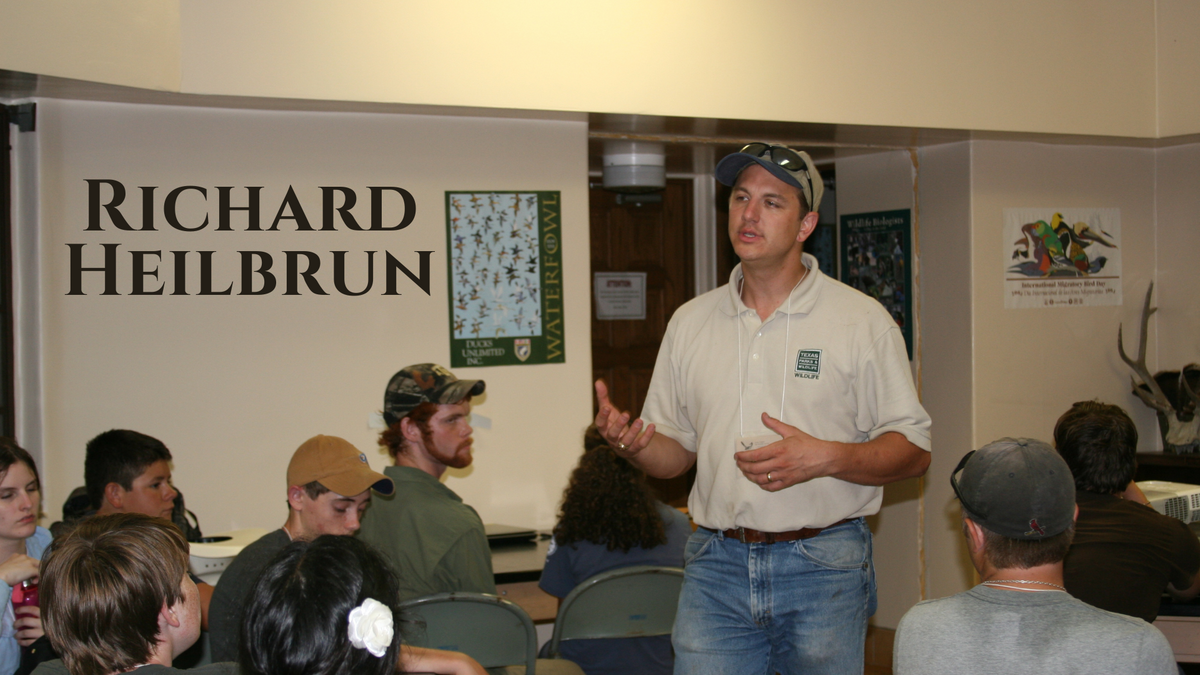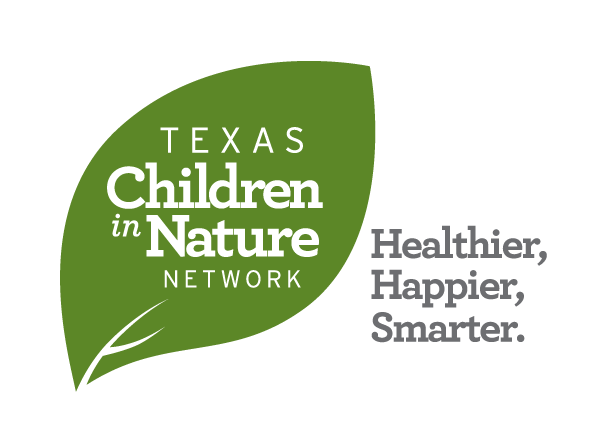
Richard Heilbrun
Ex-Officio
This past September, Richard met with Alice to share why he joined the Texas Children in Nature Network Board.
Richard, please introduce yourself and let us know a little about you:
My name is Richard Heilbrun and I have been with the Texas Parks and Wildlife Department (TPWD) for twenty-two years. My current position is the Wildlife Diversity Program Director. In that role, I supervise programs that convene around rare species, non-game wildlife, wildlife permits, and the intersection of where wildlife interacts with people. Those programs include the Texas Master Naturalists program and our citizen science program called the Texas Nature Tracker program and we have a videographer on staff for that program. We also have the Urban Wildlife Technical Guidance program that is comprised of biologists that work in and around the city to improve the quality and quantity of wildlife habitat.
I have three kids and my youngest is seventeen and she is in her senior year of high school right now. I grew up in Houston and moved around south Texas for a couple of years. I got really hooked on nature while I was growing up. In elementary school and middle school, teachers recruited me to go on special experiences involving wildlife and outdoor field trips. I didn’t realize at that time that it could be a profession. I found wildlife when I was in college and I fell in love with it. I was recently cleaning out old boxes and I found all these folders of career guidance and profiles of professionals and it was all about game wardens and biologists and refuge directors. I can't believe that consciously I didn't register that I could do this as a career, but subconsciously I must have known because I found my way. It all started with those experiences that teachers offered to me.
I grew up in Northwest Houston and lived in the back of the subdivision where Cypress Creek bordered our subdivision. That's where I spent all my time. I spent every moment I could outside on the creek, in the creek, around the creek exploring and that's how I spent every waking moment of summers and weekends. I remember my eighth-grade science teacher was a licensed bird bander and from sixth grade on I was volunteering and helping him band birds on the weekends and spring breaks and it just kept going.
What are some of your favorite activities in nature?
My family and I love camping and we camp as often as we can. Right now, we're tent camping so we're still as connected to the ground as possible. I enjoy hunting and I do that every fall. We like to go hiking so we go to Big Bend National Park quite frequently and explore state parks even more often. I'm a leader in Scouts BSA, which is formerly the Boy Scouts of America, and now that they've included girls, I'm a leader in a local girls troop. I enjoy teaching the new Scouts skills. I'm drawn towards that new discovery and that new sense of wonder and so I have assumed that role now. My daughter just achieved the rank of Eagle Scout.
What is your favorite nature spot in Texas?
I really have a soft spot in my heart for the Big Bend area. It's just incredibly special and unique. The Devil's River area of Texas is also gorgeous. It just feels like an untouched utopia. I also have very fond memories of some small places like the creek at the end of the street where I grew up. When I was a kid it seemed like a huge wilderness area, but it was, and still is, just this little urban creek, but when you're seven years old it just feels like the vast open wilderness. That little half-mile stretch of the creek still has a place in my heart. That neighborhood nature that we get attached close to home is our special spot no matter how old we get.
What interests you about the children in nature movement?
I'm fascinated by the speed with which it launched itself. It was not a slow build. Richard Louv published his book, Last Child in the Woods, and it just exploded. Many times, you hear about something for five, ten or twenty years and then it finds its footing, but once he published his book the movement absolutely exploded. I was fascinated by how many people identified with the opportunity, the challenge, and the need. Then the idea of “doing something” came together. That speed fascinates me.
Another thing that struck me in Louv’s first book is how he talked about people's fear of being in nature and the fear of sending kids into nature, like encountering strange people or getting bitten by a snake. He demonstrated that the statistics show that it is incredibly unlikely and that it’s far more dangerous to navigate urban and suburban areas than it is to be in nature. I'm fascinated with the psychology of this issue and ever since then I've really looked at the psychology of conservation and nature because I think a lot of our solutions can be rooted in how we market and talk about nature. I don't think we've solved that problem yet, but I'm intrigued by the idea of alleviating people's fears around getting people outside.
One of the other issues is the idea of access to nature. Texas Parks and Wildlife Department and lots of other groups are actively working on improving nature access, but at the end of the day, access doesn't really matter if there's still the fear factor. It's about barriers. Access and financial factors are barriers to connecting with nature. If the solutions were right there in people's faces, if they were constantly being bombarded with opportunities take their kids on field trips and all the costs are covered and all they have to do is to show up, then spending time in nature would again become an integral part of raising a kid. It’s just a given that you must send your kids on these awesome trips to these awesome places.
Why do you feel strongly about Texas Children in Nature Network?
Because our network and our partners are the ones thinking about it all the time. We're the ones that are going to keep Texas Children in Nature Network alive and continue breaking down the barriers and creating new opportunities. The easy method is just to assume the natural momentum will solve our problems, but momentum doesn’t come without a driver. Our goals won’t be met without action because there will always be something new, something fancy, something important that pops up. Our Network is going to be the ones that solves these issues.
What is some of your history with the organization?
I don't have a lot of history with the organization. I've always known about the network as something on the side and I've always focused on the management aspect of wildlife and wildlife habitat. My involvement with the network is new and I'm excited and fascinated to see the details of what we're doing and how we're doing it and what the next steps will be.
How has working with Texas Children in Nature Network made an impact on your life/profession?
I'm always looking for a way to find synergy with the things I do professionally and the things I really care about and the Network reinforces that connection. There's a lot of work still left to do to accomplish our goals. Our partners have a lot of good people and great ideas and we still need resources to make those ideas happen. I'm now much more than ever looking for those funding opportunities to help make that happen.
Why did you want to join the board?
Texas Children in Nature Network has done wonderful things and has grown from a project solely within Texas Parks and Wildlife to a nonprofit tied to TPWD and it is finding its own footing as a fully independent organization. Texas Parks and Wildlife wants the organization to keep growing and I wanted to help foster that growth.
I wanted to see how my voice and my experience can contribute to the network and it's goals. I think it's important to have that representation from Texas Parks and Wildlife on the board. I'm excited to be part of the board for Texas Children in Nature Network and I can't wait to help push the organization forward and to build on the magnificent work that we've already started.
Where would you like to see Texas Children in Nature Network in five years?
What I really want to see is the passage of the Recovering America's Wildlife Act which would bring fifty million dollars to Texas each year. An exceptionally large percentage is geared towards getting more people outside and getting more traditionally underserved communities outside. That's millions of dollars that would be geared towards helping accomplish the things that we care about.
In five years, I want to see the Texas Children in Nature Network fully integrated with the Recovering America's Wildlife Act to help use the funds to improve access to nature and get more kids out into our wild places. I cannot tell you how many times I meet with all kinds of general audiences like teachers, parents, volunteers, master naturalists, and biologists. When I talk about the potential for Recovering America's Wildlife Act and I ask them, “What would you do with fifty million dollars?” there are oftentimes no answers. Nobody has allowed themselves to dream so big. They can’t even answer that question and so I push and I push and I push and I finally say, “No, really. Tell me what you would do?” and oftentimes I'll get one teacher that very timidly raises her hand and says, “Well, I'd really like to have a set of ten backpacks for my outdoor field trips”, and I say, “Great, we'll get you the five hundred dollars for the backpacks, but we may have another seven million dollars that can be used to get kids outside”.
It takes an organization like ours to be able to manage the bigger picture, have that vision and put the plans in place to take action on a larger, broader scale. It's difficult to get this act passed and it's difficult to implement it. We would need an organization like Texas Children in Nature Network to provide the support to get the funds out to the small nature centers, wildlife refuges, and to the school districts to be able to do this work. We have spent so many years operating on a shoestring budget or pulling money out of our own pocket or doing without just to make things work that it's difficult to allow ourselves to dream big to use this money.
The Recovering America's Wildlife Act enjoys bipartisan support in both houses of Congress. It's been introduced in the Senate and we expect the House to reintroduce it soon. We already have people lined up ready to support it. It got very close to passage in the previous Congress because it is very popular. Nobody doesn't like it, everyone likes it. It's just a matter of pushing across the finish line.
Thank you, Richard, for your time today.
